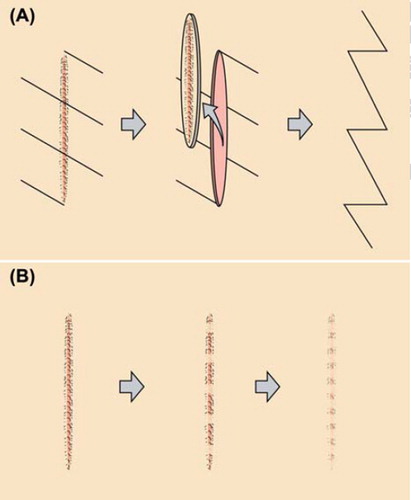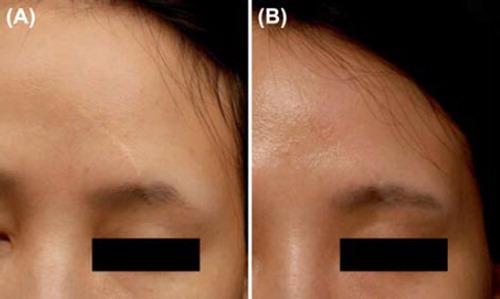Poorly oriented scars are narrow and flat, but have undesirable orientation and color mismatch (Citation1). Until recently, most poorly oriented scars caused by trauma or surgical procedures have been surgically treated with Z-plasty, W-plasty, and geographic broken line closure depending on individual scar characteristics (Citation1).
The Z-plasty procedure is composed of a double transposition flap to surgically correct scar orientation, and new lines can be made with Z-plasty in respect to relaxed skin tension lines (Citation1). However, new postoperative scars made by Z-plasty are usually longer in length, and additional new scar lines are inevitably created (). Satisfactory treatment outcomes can be expected only after well-planned and/or multiple Z-plasties by experienced surgeons. In addition, because scars mature spontaneously in the range of 6–12 months, surgical scar revision is usually performed more than 3 months following injury (Citation1).
Figure 1. Schematic view of the effects of scar revision by (A) serial Z-plasties and (B) the pinhole method using a 10,600-nm carbon dioxide laser

Scar revision procedures are aimed to optimize the appearance of scars and to improve skin texture. The use of laser devices as a nonsurgical scar revision method allows many scars to be treated during early postoperative periods (Citation2). In this report, we briefly introduce a nonsurgical scar revision technique, the pinhole method, using a 10,600-nm carbon dioxide (CO2) laser for the treatment of poorly oriented scars.
We performed three sessions of CO2 laser treatments (Model 40C, 40WA, Sharplan Lasers Inc., Tel-Aviv, Israel) with settings of superpulse mode, 2.0 W in intervals of 4–8 weeks for each case. Topical application of EMLA cream (AstraZeneca AB, Södertälje, Sweden) was used for local anesthesia one hour prior to the procedure. Then, multiple holes were made at intervals of 1–3 mm using a CO2 laser on the poorly oriented scars. Hydrocolloid dressing (DuoDERM CGF, ConvaTec, ER Squibb & Sons, Princeton, NJ, USA) was applied to the treated areas for one week. Posttherapy transient erythema and crusting are spontaneously resolved along with clinical improvements ( and ).
Figure 2. Poorly oriented scar on the wrist, which developed at the age of 21, in a 33-year-old man (A) before and (B) two months after two sessions of scar revision by the pinhole method using a 10,600-nm carbon dioxide laser

Figure 3. Poorly oriented scar on the forehead, which developed at the age of 15, in a 34-year-old woman (A) before and (B) two months after two sessions of scar revision by the pinhole method using a 10,600-nm carbon dioxide laser

The pinhole method involved making multiple small holes that penetrate from the epidermis to the deeper dermis using a CO2 laser (Citation3,Citation4). Because the pinhole method can induce regeneration and realignment of collagen bundles, improvement of dermal thickness and texture of the scars is an additional benefit which is normally observed (Citation3). Controlling energy to set the penetration depth deep enough in the dermis to induce adequate collagen remodeling and pulse duration to limit thermal damage is crucial for successful outcomes (Citation5). Puncturing the targeted lesions with a CO2 laser is convenient and results in less posttreatment bleeding and oozing and short recovery time. presents a schematic view of the effects of scar revision by the pinhole method using a CO2 laser in comparison with revision by serial Z-plasties. Z-plasty helps to realign scars in more favorable directions within relaxed skin tension lines (Citation1). However, shortening a scar in one direction will result in lengthening in the perpendicular direction. Therefore, dividing a linear scar into parts and inducing skin resurfacing by puncturing with a CO2 laser may yield cosmetically preferable results.
In our experience, CO2 fractional lasers can be effectively used for the treatment of poorly oriented scars (Citation2). However, as most CO2 fractional laser devices have been designed to provide fine beam size to maximize safety, repetitive treatments are necessary to achieve satisfactory clinical outcomes. In addition, because CO2 lasers are usually available in most dermatology clinics, we believe that scar revision by the pinhole method using CO2 lasers can be easily applied to patients with poorly oriented scars by simply changing operating parameters.
Acknowledgements
We would like to thank Dong-Su Jang, Medical Illustrator, Medical Research Support Section, Yonsei University College of Medicine, for his help with the figures.
Declaration of interest: The authors report no conflicts of interest. The authors alone are responsible for the content and writing of the paper.
References
- Shockley WW. Scar revision techniques: z-plasty, w-plasty, and geometric broken line closure. Facial Plast Surg Clin North Am. 2011;19:455–463.
- Jung JY , Jeong JJ , Roh HJ , Cho SH , Chung KY , Lee WJ , . Early postoperative treatment of thyroidectomy scars using a fractional carbon dioxide laser. Dermatol Surg. 2011;37: 217–223.
- Whang SW , Lee KY , Cho SB , Lee SJ , Kang JM , Kim YK , . Burn scars treated by pinhole method using a carbon dioxide laser. J Dermatol. 2006;33:869–872.
- Cho SB , Lee SJ , Kang JM , Kim YK , Kim TY , Kim DH . The treatment of burn scar-induced contracture with the pinhole method and collagen induction therapy: a case report. J Eur Acad Dermatol Venereol. 2008;22:513–514.
- Papadavid E , Katsambas A . Lasers for facial rejuvenation: a review. Int J Dermatol. 2003;42:480–487.